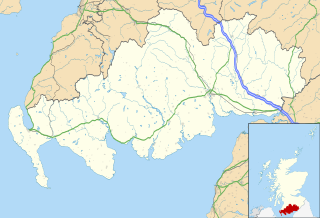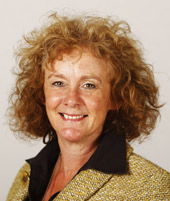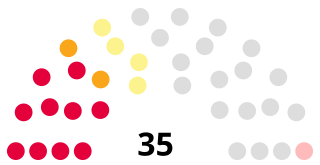
Dumfries and Galloway is one of the 32 unitary council areas of Scotland, located in the western part of the Southern Uplands. It is bordered by East Ayrshire, South Ayrshire, and South Lanarkshire to the north; Scottish Borders to the north-east; the English county of Cumbria, the Solway Firth, and the Irish Sea to the south, and the North Channel to the west. The administrative centre and largest settlement is the town of Dumfries. The second largest town is Stranraer, located 76 miles (122 km) to the west of Dumfries on the North Channel coast.

Nithsdale, also known as Strathnith, Stranith or Stranit, is the strath or dale of the River Nith in southern Scotland. Nithsdale was one of the medieval provinces of Scotland. The provinces gradually lost their administrative importance to the shires created from the twelfth century, with Nithsdale forming part of Dumfriesshire. A Nithsdale district covering a similar area to the medieval province was created in 1975, based in the area's main town of Dumfries. The district was abolished in 1996, since when the area has been directly administered by Dumfries and Galloway Council.

Stewartry was a local government district from 1975 until 1996 within the Dumfries and Galloway region in south-west Scotland. Under the name the Stewartry of Kirkcudbright the area of the former district is still used as a lieutenancy area. Dumfries and Galloway Council has a Stewartry area committee which approximately covers the same area, subject to some adjustments where ward boundaries no longer follow the pre-1996 district boundary. The Stewartry covers the majority of the historic county of Kirkcudbrightshire, and derives its name from the county's alternative name of "The Stewartry of Kirkcudbright".

Dumfries and Galloway is a constituency in Scotland represented in the House of Commons of the UK Parliament by John Cooper of the Scottish Conservatives since the 2024 general election. It was first contested in the 2005 general election, replacing Galloway and Upper Nithsdale and part of Dumfries. Like all British constituencies, it elects one Member of Parliament (MP) by the first-past-the-post system of election. Despite its name, it does not cover the whole of the Dumfries and Galloway council area.

Dumfriesshire, Clydesdale and Tweeddale is a constituency of the UK House of Commons, located in the South of Scotland, within the Dumfries and Galloway, South Lanarkshire and Scottish Borders council areas. It elects one Member of Parliament (MP) at least once every five years using the First-past-the-post system of voting. It is currently represented in Westminster by the former Secretary of State for Scotland, David Mundell, a Conservative, who has been the MP since 2005.

David Gordon Mundell, is a Scottish Conservative Party politician and solicitor who has served as Member of Parliament (MP) for Dumfriesshire, Clydesdale and Tweeddale since 2005. He previously served as Secretary of State for Scotland from 2015 to 2019. Mundell was the first openly gay Conservative cabinet minister, coming out in 2016.

Clydesdale is a constituency of the Scottish Parliament (Holyrood) covering part of the council area of South Lanarkshire. It elects one Member of the Scottish Parliament (MSP) by the plurality method of election. It is one of nine constituencies in the South Scotland electoral region, which elects seven additional members, in addition to nine constituency MSPs, to produce a form of proportional representation for the region as a whole.

Elaine Kildare Murray is a retired Scottish Labour politician. She was leader of Dumfries and Galloway Council for the 2017–2022 term. She was also the Member of the Scottish Parliament (MSP) for Dumfries from 1999 to 2011, and then for Dumfriesshire from 2011 to 2016. At the 1999, 2003 and 2007 elections, Murray increased her percentage share of the vote. She was Shadow Minister for the Environment in the Scottish Parliament. She lost her seat in 2016.

Galloway and West Dumfries is a constituency of the Scottish Parliament (Holyrood) covering part of the council area of Dumfries and Galloway. It elects one Member of the Scottish Parliament (MSP) by the plurality method of election. It is also one of nine constituencies in the South Scotland electoral region, which elects seven additional members, in addition to the nine constituency MSPs, to produce a form of proportional representation for the region as a whole.

Dumfriesshire is a constituency of the Scottish Parliament (Holyrood) covering part of the council area of Dumfries and Galloway. It elects one Member of the Scottish Parliament (MSP) by the plurality method of election. It is also one of nine constituencies in the South Scotland electoral region, which elects seven additional members, in addition to nine constituency MSPs, to produce a form of proportional representation for the region as a whole.

The 1994 Scottish regional elections were held in Scotland on 5 May 1994, as part of the Local Government (Scotland) Act 1973. These were the last elections before 29 new mainland unitary authorities, established by the Local Government etc. (Scotland) Act 1994, came into effect. The councils up for election were last contested in 1990 Scottish regional elections, and vote and seat changes are compared to the 1990 results.

Regional elections were held in Scotland on Thursday 8 May 1986, under the terms of the Local Government (Scotland) Act 1973. The previous elections had been held in 1982. The elections took place a year before the Conservative's third general election victory. Elections took place in England and Wales on the same day.

Sir Alister William Jack is a Scottish politician who served as Secretary of State for Scotland from 2019 to 2024. A member of the Scottish Conservatives, he served as Member of Parliament (MP) for Dumfries and Galloway from 2017 to 2024.

The 1990 Dumfries and Galloway Regional Council election, the fifth election to Dumfries and Galloway Regional Council, was held on 3 May 1990 as part of the wider 1990 Scottish regional elections. The election saw the Independents' majority cut to 1 councillor, but enough to keep control of the 35 seat council.
The 1977 Annandale and Eskdale District Council election was part of the 1977 Scottish local elections. This was the second election held under the new double-tiered system of the Local Government (Scotland) Act 1973. Annandale and Eskdale is an area of Dumfries and Galloway and was covered by the Annandale and Eskdale District Council and the Dumfries and Galloway Regional Council.
The 1980 Annandale and Eskdale District Council election took place on 1 May 1980 alongside elections to the councils of Scotland's various other districts. Held under the Local Government (Scotland) Act 1973. Annandale and Eskdale was also under the regional council of Dumfries and Galloway.
The first Dumfries and Galloway regional council election took place on 7 May 1974, along with the first district council elections in Scotland. This new system was created by the Local Government (Scotland) Act 1973, which saw the making of a two-tier system of local government. The area Dumfries and Galloway regional council covered also contained 4 district councils:
The second Dumfries and Galloway regional council election was held on 2 May 1978, a year after the second district council elections.
The third Dumfries and Galloway Regional Council election was held on 6 May 1982.

Elections to Dumfries and Galloway Council took place on 5 May 2022 on the same day as the 31 other Scottish local government elections. As with other Scottish council elections, it was held using single transferable vote (STV) – a form of proportional representation – in which multiple candidates are elected in each ward and voters rank candidates in order of preference.














